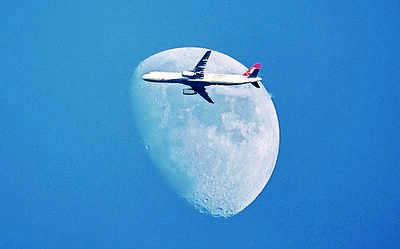Top Searches
- News
- City News
- mumbai News
- ‘Flights over India may get 200% bumpier due to climate change’
‘Flights over India may get 200% bumpier due to climate change’

Mumbai: Climate change is set to make future flights bumpier, with instances of clear air turbulence (CAT) likely to more than double over north Indian airspace post 2050, according to a study by researchers in the UK’s University of Reading.
CAT occurs at high altitudes in clear or cloudless air and, so, is the least predictable of all kinds of turbulence. “The projected increases are strongest in the northern half of India and are especially strong in the pre-monsoon season, from March to May, when we estimate that there will be 100-200% more clear air turbulence by the period 2050-2080,” said Prof Paul Williams, one of the researchers, speaking to TOI. In the future then, the importance of keeping passenger seat belts fastened throughout the flight will be more pronounced.
The researchers used climate model simulations to study the impact that climate change could have on global CAT by 2050–2080. “We found that there will be significant increases in clear air turbulence over India within the next few decades,” said Williams, a professor of atmospheric science in the department of meteorology at the Reading University. “Of all the different forms of turbulence, it is CAT that is particularly hazardous to aircraft because it’s invisible to both radar and satellite and can’t be seen by pilots from the cockpit either,” he explained.
CAT is caused by instabilities in the atmosphere, mainly in the jet stream, especially when the wind shear is strong. Jet streams are narrow bands of strong winds. “Climate change is strengthening the wind shear. We know that the jet stream over the North Atlantic ocean, for example, is already 15% more sheared than when satellites began observing it in the late 1970s. And our studies have used climate models to show that this effect will increase the amount of severe CAT by hundreds of percent in the next few decades,” he said.
In India, currently, turbulence is largely associated with thunderstorm clouds, which can be detected by the aircraft radar. The study does not cover the impact of climate change on this kind of turbulence. Capt Amit Singh, founder of NGO Safety Matters Foundation, said: “In India, CAT is mostly encountered in the northern parts where most of the jet stream is prevalent. The last encountered CAT-related incident was Air India-462.” He was referring to flight AI-462 that took off from Amritsar on April 19, 2018, encountered severe turbulence unexpectedly between 16,000 ft and 19,000 ft, and left three passengers injured.
In the past two years, turbulence has injured close to two dozen passengers in India in two separate incidents (June 2021 and May 2022). In last year’s incident, one flyer eventually succumbed to spinal injuries. Both incidents involved turbulence associated with thunderstorm clouds over north India.
CAT occurs at high altitudes in clear or cloudless air and, so, is the least predictable of all kinds of turbulence. “The projected increases are strongest in the northern half of India and are especially strong in the pre-monsoon season, from March to May, when we estimate that there will be 100-200% more clear air turbulence by the period 2050-2080,” said Prof Paul Williams, one of the researchers, speaking to TOI. In the future then, the importance of keeping passenger seat belts fastened throughout the flight will be more pronounced.
The researchers used climate model simulations to study the impact that climate change could have on global CAT by 2050–2080. “We found that there will be significant increases in clear air turbulence over India within the next few decades,” said Williams, a professor of atmospheric science in the department of meteorology at the Reading University. “Of all the different forms of turbulence, it is CAT that is particularly hazardous to aircraft because it’s invisible to both radar and satellite and can’t be seen by pilots from the cockpit either,” he explained.
CAT is caused by instabilities in the atmosphere, mainly in the jet stream, especially when the wind shear is strong. Jet streams are narrow bands of strong winds. “Climate change is strengthening the wind shear. We know that the jet stream over the North Atlantic ocean, for example, is already 15% more sheared than when satellites began observing it in the late 1970s. And our studies have used climate models to show that this effect will increase the amount of severe CAT by hundreds of percent in the next few decades,” he said.
In India, currently, turbulence is largely associated with thunderstorm clouds, which can be detected by the aircraft radar. The study does not cover the impact of climate change on this kind of turbulence. Capt Amit Singh, founder of NGO Safety Matters Foundation, said: “In India, CAT is mostly encountered in the northern parts where most of the jet stream is prevalent. The last encountered CAT-related incident was Air India-462.” He was referring to flight AI-462 that took off from Amritsar on April 19, 2018, encountered severe turbulence unexpectedly between 16,000 ft and 19,000 ft, and left three passengers injured.
In the past two years, turbulence has injured close to two dozen passengers in India in two separate incidents (June 2021 and May 2022). In last year’s incident, one flyer eventually succumbed to spinal injuries. Both incidents involved turbulence associated with thunderstorm clouds over north India.
Start a Conversation
FOLLOW US ON SOCIAL MEDIA
FacebookTwitterInstagramKOO APPYOUTUBE









